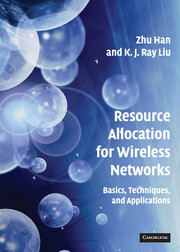4 - Rate Adaptation
from Part I - Basics Principles
Published online by Cambridge University Press: 05 August 2012
Summary
Introduction
Rate adaptation is one of the most important resource-allocation issues, because the system can adapt the users' rates so that the limited radio resources can be efficiently utilized. Compared with power control, rate adaptation gives a newdimension of freedom to change the information transmission rate over time, i.e., power control maintains the desired link quality, whereas rate adaptation adjusts this link quality. In this chapter, we give an overview of the rate-adaptation system: where and how the rates can be changed; what the challenges and constraints are; and how rate adaptation can be combined with other techniques.
According to the different ISO (International Organization for Standardization) layers, rate adaptation can be classified into three different types: source rate adaptation in the application layer, rate control for data communication in the network/MAC layer, and channel protection adaptation in the physical layers. They are briefly summarized here:
• Source Rate Adaptation
This type of adaptation adjusts the quality of transmitting information. For example, the voice encoder can change the information rate according to the talking period and the silence period, as it is useless to have a high data rate for the silence period. For video transmission, the data rate is very bursty over time, because of the different video scenarios and different frames such as I, B, P frames. Because the capacity to deliver the information is limited by the communication systems, the design of the wireless network protocol shall carefully consider the source rate adaptation so that the received information has high quality using the limited system resources.
[…]
- Type
- Chapter
- Information
- Resource Allocation for Wireless NetworksBasics, Techniques, and Applications, pp. 75 - 98Publisher: Cambridge University PressPrint publication year: 2008
- 1
- Cited by



